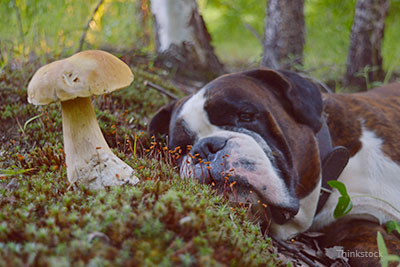 So, when it comes to mushrooms, how does a dog guardian know which ones are poisonous versus which ones are safe?
So, when it comes to mushrooms, how does a dog guardian know which ones are poisonous versus which ones are safe?
There are thousands of mushrooms out there, but only about 100 types are poisonous. (Don’t worry about mushrooms sold in large-chain grocery stores – these are safe and considered non-toxic to dogs and humans). Depending on what type of mushroom is accidentally ingested, poisoning can be seen even with just a small bite. Mushrooms are very difficult to identify, and that should only be done by mycologists.
When in doubt, we veterinarians always assume worst-case scenario… that each mushroom is poisonous when ingested by dogs or cats. When it comes to mushrooms, they can result in different types of poisoning, depending on what species of mushroom is ingested.
[Editor's Note: Don’t worry about memorizing each kind of poisonous mushroom, as you will see here, Dr. Lee’s advice is the same regardless of which mushroom you think your dog ate.]
- The most dangerous type of mushroom is the Amanita, which contains amanitin toxins. Clinical signs seen from this mushroom include severe gastrointestinal signs (within 6-24 hours), a “false recovery” period (where your dog appears to get better), and then severe liver failure (at 36-48 hours post-mushroom exposure). Acute kidney injury (AKI) can also develop in the end stages. These types of deadly mushrooms include Amanita, Galerina, Lepiota, A. phalloids (death cap, death angel), and A. ocreata.
- The Inocybe spp. and Clitocybe dealbata mushrooms contain the toxin muscarine and cause profuse SLUDE signs (e.g., salivation, lacrimation, urination, diarrhea) and neurologic signs.
- Amanita muscaria and A. pantherina are a different type of Amanita that contain the toxins muscimol and ibotenic acid. Clinical signs from this type of mushroom include ‘walking drunk,’ severe sedation, tremors or even seizures.
- The false morel (Gyromitra spp.) causes profuse vomiting and diarrhea and is generally not fatal. Rarely, it can cause seizures.
- Some types of mushrooms just cause gastrointestinal irritation (e.g., vomiting and diarrhea) and are rarely life threatening when ingested. Signs can be seen in 1-6 hours, and generally resolve after 1-2 days. These types of mushrooms include the following types: Agaricus, Boletus, Entoloma.
- Hallucinogenic mushrooms aren’t life-threatening and rarely need treatment. That said, signs of ataxia (acting abnormal, howling, abnormal eye movement and hyperthermia) can be seen when dogs ingest them. These types of mushrooms include the following types: Psilocybe, Conocybe, Gymnopilus spp.
What if you notice your dog eat a mushroom?
If you notice your dog eat a mushroom, get to a veterinarian or emergency veterinarian immediately. The sooner you bring your dog in, the sooner we can decontaminate (e.g., induce vomiting or administer activated charcoal to bind the poison from the stomach) and treat your dog; this will be less expensive and less damaging to your dog. Additional treatment often includes IV fluids, blood work monitoring (for 2 days), liver protectant drugs, anti-vomiting medication, and supportive care. If you wait until clinical signs develop, it may be too late to treat your dog effectively.
When in doubt, you can always call your veterinarian, emergency veterinarian, or ASPCA Animal Poison Control Center for life-saving care at 888-426-4435.
If you have any questions or concerns, you should always visit or call your veterinarian -- they are your best resource to ensure the health and well-being of your pets.
